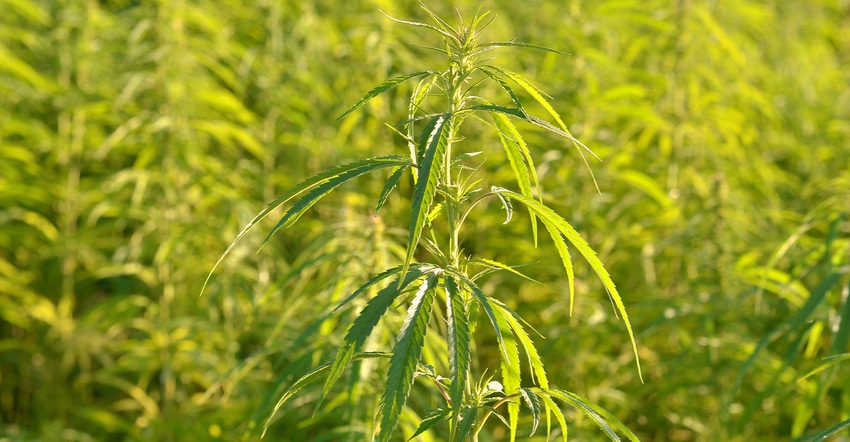July 9, 2019

Tough times in any business will have owners seeking new income opportunities. For farmers, five years of below-average crop prices mean questioning whether the crops you raise today are right for the future. And for many, a potential choice is to evaluate industrial hemp.
R. Brent Young, regional Extension specialist in Sterling, Colo., recently issued a release digging into some key factors growers should consider before making the leap into the crop. This new crop, enabled by the 2018 Farm Bill, has created a lot of buzz in agriculture, but Young issued some cautions regarding the crop.
Industrial hemp has the same botanical name as marijuana — Cannabis sativa — but the tetrahydrocannabinol, or THC, that brings the “high” must be lower than 0.3% on a dry weight basis. At that level, the crop is classified as industrial hemp.
Young says farmers should look at five key areas to evaluate the potential for the new crop: price, production, legal, financial and human risk.
1. Price. Young defines price risk as the fluctuations in prices paid for inputs or received for outputs. “The major issue for industrial hemp in this risk category is the lack of price discovery function,” he says. “It is very difficult to determine the price of hemp fiber, seed or flower at any given time.”
Traditional ag commodities, including corn, wheat and cattle, are traded on public markets, and price information is easily available. That’s not true for hemp.
“It is difficult for producers to determine if a price offered for a hemp product is a fair price,” he says. “Is the offered price sufficient to lock in a profit? Are prices likely to go up or down in the future? Should I lock in a price now or wait a few months? These are just a few questions that a producer contemplating producing hemp will need to answer.”
He says the lack of price transparency can lead to an unfair price advantage when buyers and sellers negotiate prices.
2. Production. Yield fluctuations for quantity and quality are concerns on the production risk side. One tool farmers use to mitigate production risk is through crop insurance. Industrial hemp is approved for inclusion in the federally supported crop insurance program, but Young cautions that it may take several years of data collection to develop the actuary tables needed to determine premium rates for this crop.
“Whole Farm Revenue Protection policies may be available in the short term,” he says. “However, the hemp crop must be produced under contract to qualify.”
Other concerns include the ability of underwriters to offer insurance for hemp being grown for CBDs due to the high value of the crop and potentially large losses. Finally, whole farm insurance will not cover losses due to the crop testing over the 0.3% THC limit.
Another production risk is pest control. Few pesticides are registered for use on industrial hemp.
3. Legal risks. Young defines this as “anything that changes the rules of the game or causes outside influences on the business.” Those must be evaluated, and currently there are not quality standards for hemp, unlike most traditional crops. Corn, for example, is sold worldwide as U.S. No. 2 yellow corn. USDA has developed specifications for corn, as well as methods to determine those specifications.
Lack of quality standards for hemp makes it difficult to develop production contracts as the buyers and sellers could have wide-ranging views on what criteria to use to determine a good product from a poor product.
Another concern is the legal risk on the current status of CBD’s with the U.S. Food and Drug Administration. To date, only one CBD has been approved by the Food and Drug Administration to treat a medical condition. Currently, these cannabidiol products are promoted as a potential treatment for a wide range of medical conditions. Although future research may show that CBDs are effective, the research has to prove they are effective and safe, Young says.
4. Financial. Most stress many farmers face today is based on financial risk. This fourth category of risk is defined as a condition of “not having sufficient cash to meet expected obligations, generating lower-than-expected profits and losing equity,” Young says.
One way to avoid this risk is to grow hemp under contract. Young says in Colorado, someone offering a contract to grow industrial hemp or buy hemp-related raw products must hold a Farm Products and Commodity Handlers license issued by the Colorado Department of Agriculture. In other states where farmers are contemplating hemp contracts, knowing state rules will be a key to protecting a farm’s interests in any deals made.
5. Human risk. This area is defined as uncertainty about the character, health or behavior of the people involved in the business. Young says the U.S. hemp industry has been referred to as the “Wild West” or a modern-day gold rush.” “With so many players involved, it’s difficult to tell the good guys from the bad guys,” he says. “It is very important to carefully vet all potential business relationships before making a deal and to be cautious of those opportunities that seem too good to be true.”
Young can be reached at [email protected].
Source: Colorado State University. The source is solely responsible for the information provided and is wholly owned by the source. Informa Business Media and all its subsidiaries are not responsible for any of the content contained in this information asset.
You May Also Like




